Menus
- Honda CRF1000L Africa Twin ABS and DCT version
- The legend resumes its march
- Discovery
- In the saddle
- In the city
- Motorway and expressways
- Departmental
- All Terrain
- Part-cycle
- Braking
- Comfort / Duo
- Consumption
- Conclusion
- Colors
- Main equipment
- Comfort pack € 1,296
- Travel pack € 1,391
- Expedition Pack € 2,662
- Equipment details
Honda CRF1000L Africa Twin ABS and DCT version
Legends never die. Like the phoenix, the Africa Twin is reborn from the sand of its past exploits in a machine as accessible as it is efficient. Ideal successor to its glorious elder, the novelty takes up the codes to deliver the best of the trail concept and validate the Honda concept: Go Anywhere (go anywhere).
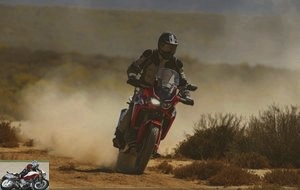
The legend resumes its march
Africa Twin…. More than a surname, these two words alone describe a motorcycle legend that still resonates with adventure, with victories in competitions but also with versatility for its civilized variation. In 1986 the Honda NXR 750 prototype won the Paris Dakar. Two years later, the XRV 650 Africa Twin was released to the public. Powered by a 57 hp V-Twin, its versatile cycle part allows for real offroad outings. Evolving into CRV 750 in 1990, it then delivers 61 hp and will remain unchanged until its disappearance from the catalog in 2003. Its six-valve V-twin with an "indestructible" reputation makes it, even today, a sought-after machine. high coast. Following it, the XL 1000 Varadero, much sportier with its block from the sporty VTR 1000, brought the family into the road maxi-trails. No longer really suitable for all terrain but efficient on asphalt. An evolution that the VFR 1200 X Crosstourer has completed to design, with its 130 horsepower V4 engine, an optional DCT robotic gearbox and a weight of…. 285 kilos. This GT on stilts therefore left room in the Honda range for a more versatile, lighter and more adventurous machine. In short, for the return of a typical Arlesienne raid with the scent of hot sand.

Since 2003, the trail segment has grown considerably, with machines as powerful as they are far removed from the very concept of original versatility. Having become a myth, the Africa Twin was therefore made to wait 12 years before making its big comeback. It is an understatement to say that the Honda trail is of particular importance for the winged brand. A prestigious machine, an extraordinary press launch. It is in South Africa that the manufacturer of Hamamatsu invites us to discover her new desert daughter. On the program, two test days to test the novelty both on the road and on the track. But also to evaluate the version with mechanical gearbox and that with robotic clutch. And, if the twin has changed type from V to parallel, we can already say that the Africa Twin 2016 lives up to its name..
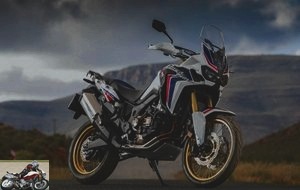
Discovery
The new opus is in every way the modern translation of its venerable ancestor. Strong character, versatility and image. Difficult to reinterpret a myth. And yet, this is exactly what the Italian designer Fabrizio Carbonara has accomplished with talent. The essential aesthetic points, certainly modernized, refined, are present on the Africa Twin 2016. Double optics, narrow air intakes anchoring the lights, curve of the fork crown, long shoulders hiding the radiator with double extractor, metal shoe … . All the stylistic codes are there, bearing the undeniable signature of the former queen of rallies. It is in the Replica version that the novelty is the most attractive, featuring gold rims and a tri-color dress making the filiation obvious..
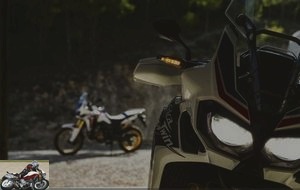
The general finesse of its design also evokes the most recent competition machines, just as its code CRF1000L recalls the enduros of the winged brand. Narrow, compact, the front face stretches its lines, from the top of its stylish but non-adjustable bubble, to the ends of its scoops. Its narrow lights also evoke another glory, competing sport and now civilian, with three tuning forks. But the Honda knows how to keep its own image. Its tapered look, finely rounded and composed of LEDs, remains elegant, skillfully framed by a black rimel and highlighted by a return of the fairing. This dynamic front end continues on the sculpted curves of the 18.8-liter tank. The bottle is then sharply refined at the level of the seats, anchored by large passenger grab handles. This rests on a sheathed rear buckle, with taut lines, integrating the attachment systems of the optional luggage. The assembly rests on a rear loop in tubular steel trellis, welded to the main frame. A choice combining advantages and disadvantages. In the event of a big fall, especially with suitcases, the stern could twist or break. It is then easier to change a bolted buckle. But at the end of the world, welding steel is simple…. and much cheaper than changing such a part.
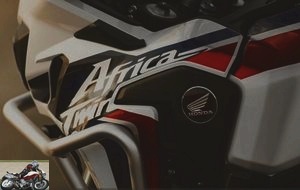
The finish of the Africa Twin is at Honda standard, flawless. Elegant casing, engine casing in bronze color, careful adjustment of the elements, quality components and studied ergonomics, the trail provides top-notch services. The mechanical design is to match, as are the electronic aids available. The rest of the technical details can be read in the corresponding section.
In the saddle
With a significant ground clearance of 250 mm, guaranteeing assumed offroad inclinations, the Africa Twin has a standard saddle height of 870 mm. Easily adjustable by placing it on low bindings, the altitude is then reduced to 850 units. These values may seem important but, the African woman having an hourglass figure, the leg arch is reduced, providing good stability of the feet on the ground. My eighty-four meter fits there easily and might even appreciate the optional high saddle (880-900mm). In contrast, a low seat (820-840 mm) will tempt the less tall. Reduced, the flexion of the legs induces a comfortable position, barely spread by the studied curve of the 18.5-liter tank.
Straight bust, we barely raise the forearms to place the hands on the large hanger with the marked horns. High saddles raise it off the top tee, dominating the nose gear rebound settings positioned on the top of the tubes. Sheathed, the fork then is dominated by a neat cockpit, integrating a fully digital instrument block. Negative type on a midnight blue background, the display brings an undeniable elegance. The upper window contains tachometer, tachometer and yellow fuel. The lower rectangle combines a lot of information; Above, clock, anti-slip level indicator (three-value HSTC and cut) and very readable gear indicator. Below, the indications can be chosen by the user on three levels: outside temperature or travel time, then average speed and consumption, instantaneous and at the base odometer, two partial and engine temperature. Everything is controlled on the left stalk and framed by conventional indicator lights or recalling the disengagement of the HSTC and rear ABS. The first by a trigger on the handlebars, the other via a square button in the cockpit.
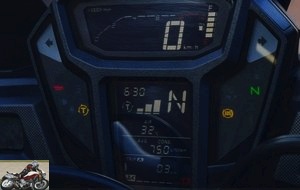
On the DTC version, an additional pushbutton enables Gravel mode to be engaged (off-road clutch adjustment) for a more direct transmission. Other commands directing the box dress the right commodo. Mode D (Learning Drive) and S (Sport) now with three variables, densify the display.
All this may seem a little confusing but, in use, the ergonomics of the whole is very correct. We regret unsheathed passenger footrests and the obligatory use of the central stand option. The levers are housed behind reinforced hand guards as standard, but only the brake lever is adjustable in spacing. Finally, if you look for the tool kit under the rider saddle, you will only find an alen key…. which will allow you to open the toolbox located under the left frame. Little supplied, it has 5 tools.
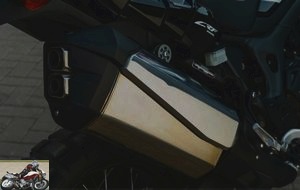
In the city
The 270 ° setting of the twin delivers immediately identifiable music. Irregular and muffled, its growl is hectic with each gas stroke. A mechanical life amplified as it should by the exhaust, bringing sound to the Africa Twin like a big civilized enduro. This gender balance is found at all levels on the machine.
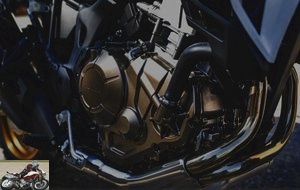
The feeling that dominates the grip is facilitated. Almost obvious, we quickly find our marks on the handlebars of the Africa Twin. Its general narrowness and a cycle part favoring comfort and control, give great ease to the controls of the new Honda vessel. Responsive but gentle, the CRF1000L is a perfectly trained frame. Available, the block resumes from 2,500 laps on the intermediates and the trail is easily placed in traffic. Its very convincing turning circle (4.90 m) allows easy maneuvering in town. Selection and clutch lever of the mechanical version operate smoothly and precisely. As for the DTC box, it further raises the general approval of the Honda in urban evolution. Only fairly flexible suspensions cause more sensitive mass transfers, but without excess, in the syncopated circulation of local towns. Pleasant at all times between the walls, the Africa Twin is however cut out for other adventures than that of crowded cities..
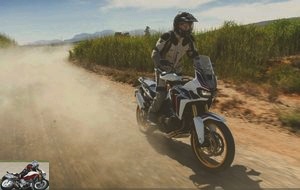
Motorway and expressways
Capable of peaking at 220 km / h when approaching the breaker at 9,500 turns, the Africa twin is especially particularly stable at high speed. Its wheelbase higher than the segment average and good aerodynamics allow it to cross at good speed without chassis movement. To be confirmed with the carrying of suitcases and top case.
At the legal motorway, at 5,800 laps, the Honda also provides good protection to the air flow despite a non-adjustable bubble. Nicely designed and with numerous cutouts to avoid turbulence, the windshield effectively deflects the pressure on the helmet of older children. Only the end of the shoulders remains more exposed. A larger bubble, optional, will ensure even more comfort. That of the seats is remarkable and unusual on an original saddle. In cold weather, we will feel more a lack of protection in the legs. The delicacy of the dressing is the cause.
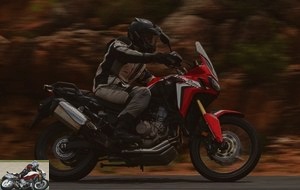
Crossing at higher speeds happens almost naturally, as the engine is voluntary. The only regret in this regard, the absence of a regulator. Versatile machine with adventurous tendencies, the trail has forgotten this road trick. Suitable for long asphalted journeys, the trail will be tasted much better on the secondary network anyway..
Departmental
Our first day of driving takes us on the South African road network. Honda is pleased and affirms it, the twin of 998 cm3 delivers linear accelerations. An aspect rarely emphasized in these times of over-motorization at all costs. Linear And powerful, however, specifies the manufacturer. In fact, the CRF1000F does not lack a trunk. Its twin offers two faces. After 6,000 laps, the times are ample and the block displays a more marked character. Yes, character, on a Honda. Like that of a CB500, the large parallel twin of the Africa Twin knows how to mutate to boost its evolutions. He likes to climb the towers by metallizing his vocalizations. Its 95 hp energize the journeys without difficulty, without the excess of bloated cavalry suddenly taking the bites in the teeth. However, we remain here in a bold and controlled register, without frantic flight. Wishing at all costs to "stick" to the spirit of the original, the novelty displays interesting power and torque curves. While much higher, they are parallel, like its twin, to those of its ancestor. A detail that will appeal to connoisseurs and fans of the first version.
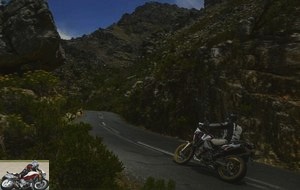
To manage these good mechanical arrangements, the chassis is not left out, also delivering real big trail behavior. Soft, the damping can swallow any defect of small South African roads and move at a good pace in flying carpet mode. It moves a little on the local corrugated iron, with variable sinusoids, but always in full safety. The management of the end-of-travel suspension, which is very progressive, is remarkable. In coiled driving, the Africa Twin is then formidable in efficiency, barely making its 21-inch front wheel feel. Relatively open column angle (27.5 °), studied stiffness / flex ratio of the frame and rear tire in 150 provide appreciable agility to the CRF1000L. Without being the liveliest in the segment, the Honda does not lag behind when changing angles. The wide handlebars combine with the footrests to effortlessly guide the wader. Once placed on the side of its tires, it always stays on course and easily allows course corrections. Breaks and other bleedings barring the curves barely move the Japanese adventurer. And if, however, more sportiness was desired, the suspension adjustment then significantly optimizes the behavior of the machine..
If the mechanical gearbox is always pleasant, its automatic counterpart with double clutch is just as appreciable. Mode D studies your driving and tries to stick to your wishes. Excluding sporty driving, it actually officiates as close as possible to your desires, returning a report if necessary to revive the crew or tackle a bend. However, if you want to tame a little, the choice of level three Sport mode then almost allows you to find a manual gearbox behavior. The efficiency is as astonishing as it is addictive, the gears engaging without any jerks or delays. You can also force the choice of gears using the paddles on the handlebars or switch to manual mode. And as the grip of the Dunlop Trailmax is flawless, the rubber is quickly martyred by the torque of the large vertical twin. If necessary, traction control limits loss of traction in the drive casing. Placed in mode three, it turns out to be intrusive in sport driving, burdening the reminders. Adjusted to 1, it works perfectly.
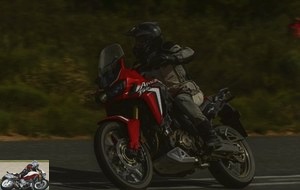
Enough to regularly test the Africa Twin’s braking system. And on this point too, the Honda ensures, with front calipers as progressive as they are powerful, leaving the steering free of any interference. To smooth the trajectories in curves, the opposite element requires breaking the ankle more. An advantage for more precise control of the rear wheel in offroad.
All Terrain
This is indeed his reserved domain, his promised land. The Africa Twin doesn’t just look versatile, it’s a true trail runner. Certainly, its narrow size, its typical chassis and its precise and ample engine behavior made one guess. But it was on the second day of testing that the Honda was able to convince. On the program, long sandy and rocky tracks, more or less narrow and winding. Ideal for revealing the true face of the CRF1000L. The Africa remains a big trail of 232 kg excluding DTC (+10 kg), but benefits from an unusual balance. Its cycle part turns out to be "human", allowing easy control at all times and effective corrections of any errors..
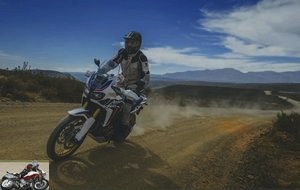
Now shod in Continental TKC 80 Twinduro, the driving trail effortlessly in the fine gold of the local sand. Standing on the ideally placed toe clips, just like the handlebars, I focus on the paths to follow but above all on the pleasure of riding. If sometimes the "Total Control" dear to Honda can seem intrusive, it takes on its full meaning here. Especially since mechanics and exhaust bring it life and dynamism usually behind in the winged manufacturer. Vibrant, "Africa" traces its way in sheaves of dust, its front wheel surfing on the tender furrows of my rally of the day. My test raid takes on the appearance of outdated competition riding the revisited legend. The drifts of the rear wheel are managed with precision while its deactivated ABS allows to increase the pace in the narrow passages downhill. Finally, the fork and shock absorbers work over their entire travel, gently receiving the machine from slight flights or absorbing the biggest shocks..
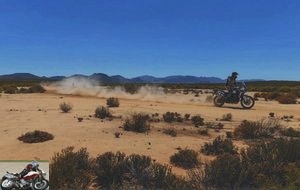
Taking the handlebars of the DCT model, we quickly perceive the approval of this automatism in evolution all the way. However, even in Sport 3 mode, the gearbox sometimes goes up an unwanted gear, forcing you to downshift using the handlebars or the optional electronic selector. G (Gravel) mode didn’t seem to bring any real change when it was activated. Sense given a more efficient response from the box and let the rear drift more frankly, the system does not transcend behavior. Likewise, ascent and especially descent under its automatic control seems to be improved in order to be effective. Finally, the higher weight of the Africa Twin in the DCT version is sensitive, significantly reducing the ease of the machine in offroad maneuvers..
Part-cycle
Undoubtedly the strongest point of the machine, combining balance and performance both offroad and on asphalt. Designed to get out of the asphalt, the Africa Twin pays no tribute to this choice, its typical geometry easily accommodating road use. Whatever the use, the CRF1000L swallows small or large defects of the chosen route.
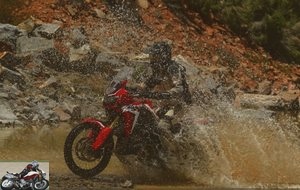
Braking
Powerful and enduring, the system does not lack progressiveness, both front and rear. Modulated or energetic, taking the brakes delivers exactly the desired result. ABS is also very satisfactory.
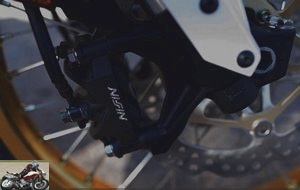
Comfort / Duo
Without reproach, soft seats and quality suspensions contribute to the remarkable comfort of the Africa Twin. With its generous grab handles surrounding a welcoming saddle, the accompanying person benefits from the same treatment. Ergonomic, the general position on board satisfies the crew’s long trips. Only regret, the footrests of the accompanying person are not sheathed.
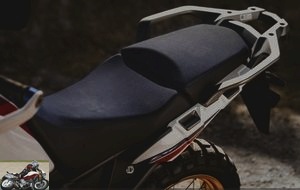
Consumption
With an 18.8-liter tank and fuel consumption varying between only 5.4 liters on the road and 7.3 on the offroad, autonomy is satisfactory but may seem fair to adventurers fleeing the asphalt. The others will, like us, be amazed by the poor appetite of the big twin of 998cm3.

Conclusion
Efficient, dynamic, attractive, the Honda CRF1000L Africa Twin is making a comeback, resuming its legendary march. As effective on all terrain as it is comfortable on the road, it features attractive plastic and a leading finish. Its electronic assistance and an automatic transmission version further optimizes its approval. It is difficult to blame it for a lack of power as it is available and adapted to the concept. Very close to the spirit of the original machine, the novelty is placed at the highest level of general performance compared to comparable machines. Even its price of € 12,999 (€ 13,299 for the Replica version and € 1,000 more for the DTC version) seems well placed..
And it is suddenly very hot in the segment, the Africa Twin dropping a blazing sun on direct competition. Starting with the KTM 1050 Adventure, asking € 12,900. Its power is identical but its dress less attractive. More sporty, its behavior does not offer the same evidence and its suspensions less approval. As for comfort, the KTM has forgotten good manners. Finally, it will be necessary to put the hand in the pocket to obtain the ABS enduro (deactivating the rear) and the spoked rims…
Another challenger to sweat, the Yamaha XT1200Z Super Tenere, posted at 13,999. Close in concept with a line that smells of the dunes, in mechanics with a twin of the same type, the Yam ‘is more powerful but also heavier and less lively.
Finally, the Triumph Tiger 800 XCx, € 12,700, is perhaps the most able to follow the debates launched by the Africa Twin. However, fairer in torque, its three cylinder will struggle in duo or when the machine is heavily loaded..
Yes, but the BMW R1200 GS will you tell me? Without being irrelevant, she is not exactly from the same world.
Honda has put all its know-how into this fully accomplished model. Strong and sporty aesthetics, sleek volumes and perfectly usable mechanics make the Africa Twin the new benchmark for real big trails. With her, adventure is more than ever around the corner.
Strong points
- Evidence of handling
- Engine character at mid and high revs
- Agility and precision of the chassis
- All-terrain efficiency
- Ergonomics
- Electronic assistance
- Suspensions
- Sound
Weak points
- Engine lacking in tone under 5,000 rpm
- No central stand as standard
The Africa Twin technical sheet
Colors
Black – black rims
Gray – black rims
Red-white – black rims
Replica (+300 €) – Gold rims
Main equipment
Comfort pack € 1,296
- 12V
- sump guard
- anti-fog
- heated grips
Travel pack € 1,391
- top case and support
- suitcases
- central stand
- high windshield + 70mm
Expedition Pack € 2,662
- Comfort pack + Travel pack
Equipment details
- Suitcases – Right: 30 L / Left: 40 L – Direct stowage on the motorcycle, left suitcase that can contain a full face helmet: 659 €
- Topcase 35 L houses a full face helmet, standard backrest: 449 €
- Thin and comfortable handles, control integrated in the left handle, 5 heating levels
- High clear windshield, height +100 mm, width +30 mm: 159 €
- Dimensions as original, 70% tinted: 149 €
- Set of 2 passenger footrests, make it easier to get in the saddle, minimize vibrations: € 99
- DCT selector + programming box: € 424
- 12 V accessory socket, powers your electronic accessories, suitable for a GPS, smartphone, etc. : 72 €
- Low saddle: standard room -30 mm (i.e. 820 mm in low position): 224 €
- High saddle: standard room +30 mm (i.e. 900 mm in high position): 224 €
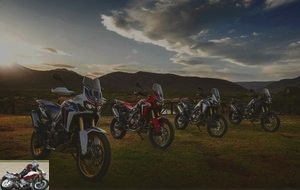
Related articles
-
Face to face with the 2016 DCT and ABS trail versus the 2001 vintage Saga Africa As a reminder, the origin of the Africa Twin is a prototype, the NXR 750…
-
Honda Africa Twin test in the mud
Three levels of traction control, disconnectable ABS, DCT: useful, or not ? A life-size test at the Honda Adventure Center in Wales A real commercial…
-
Comparo Honda CRF1100L Africa Twin and Adventure Sports
Two Africa Twin 1100 for the price of one! or the opposite ? Angry backpackers After a masterful comeback in 2016, the Honda Africa Twin CRF1000L…
-
Honda Africa Twin CRF1100L Adventure Sports motorcycle test
100 hp, 105 Nm at 6,250 rpm, 238 kg all full (250 kg in DCT / EERA), 16,899 euros (19,399 euros in DCT and EERA suspensions). The spirit is there It…
-
Some subtle changes for the 2018 version of the trail In-line twin, 998 cm3, 95 hp at 7,500 rpm, 98 Nm at 6,000 rpm, from 237 kilos, from 13,549 € The…
-
Comparo Honda X-ADV / Africa Twin
Vendetta Sino-Corsica With two flagship models, Honda returns to adventure and versatility. Both the return of the legendary CRF1000L Africa Twin and the…
-
Honda Africa Twin Adventure Sports test
Honda returns to the adventurous spirit of the original Africa Twins In-line twin, 998 cm3, 95 hp at 7,500 rpm, 98 Nm at 6,000 rpm, from 243 kilos, from…
-
The return of simple pleasures Good news for dynamic riders, the sport touring segment seems to be expanding again. Some already hold the pavement for a…
-
Motorcycle comparison BMW 1250 GS / Honda Africa Twin 1100
Potato or mash ? BMW R 1250 GS 136 hp, 143 Nm at 6250 rpm, 249 kg all full, 17,600 euros (21,294 euros for the model tested with Comfort, Dynamic and…
-
GT-Cruiser of the 3rd type The winged builder keeps up his ideas and keeps revisiting the contemporary bagger style. After the F6B and very soon F6C,…
So, then, do we have to specify everything?
Price :
€ 13,000 are accessible compared almost € 16,000 for a GS without option. And given the quality of the Japanese, it’s a very correct price.
Weight:
we all prefer to endure with a 250. But that’s not the problem, because here we are testing a big trail for those who travel in big trail. And, as such, the Honda was designed to remain efficient in offroad..
So yes, it still weighs 232 kg, but we are amazed by its ease vs size-performance
Indeed I do not see them on the other hand Franck I think I saw your post on the Africa forum
Yes, I signed up for two Africa Twin forums.